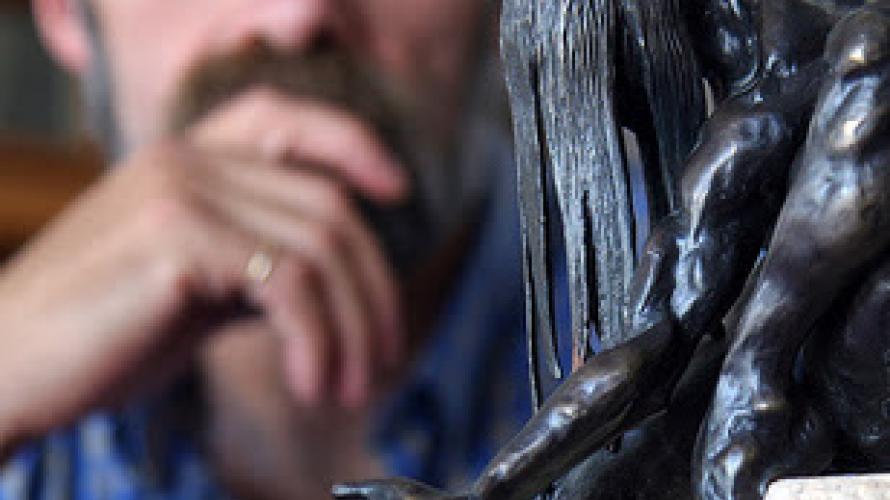
Hearing His Own Voice: Tim Holmes, Sculptor
~Brian D'Ambrosio
Sculptor Tim Holmes’ overarching body of work can be interpreted as a testament to his passion. Art is so demanding, and can be so thankless, that the only people who do it for as long as Holmes has are those who cannot imagine feeling fulfilled any other way.
“The word artist feels like a misnomer to me because I’m really just a creative individual just like everyone else,” said Tim Holmes. “But sometimes I feel like a misfit to be honest. I’m introverted and spiritual in an extroverted and very materialistic culture, and I’m so removed from the pulse of mainstream culture. As a symptom of that I try to hear my own voice and create this new culture (through my art).”
Noted for his deft use of magical realism, Holmes the artist is inseparable from his personality: circumspect, tenderhearted, a man bursting at the buttons with emotion and empathy. Sculpture and mixed media and their emotionally-sourced creativity allow him to discover – and at times even recover – his mental footing by returning to what feels comfortable.
It was decades ago when Holmes, 62, made the choice to just do it, to take the kernel of an idea and to believe in it, and to embellish it into a surviving piece of art.
“Forty years ago I decided that I was going to do more than just making a living as an artist,” said Holmes. “Making a living? Yeah, that’s one thing. But I was making a life. Everyone needs to create a pursuit. But as an artist there is a pressure on you, and that’s a whole different kettle of fish.”
Holmes adjusted not just to the realities of business but to a new self-identity, all while under strong financial pressure. He didn’t give up.
Instead, he turned necessity into opportunity. He drew upon his self-determination, his creativity, and his fortitude in ways he never thought possible. Long since driven by necessity and opportunity, he learned to invent (and reinvent) himself through sculpture and mixed media.
“I do think of art as being alive, and not to have that would be to stop growing, and I don’t want to do that. Being alive – like art – is always uncomfortable and it always takes courage.”
Indeed, Holmes has lived such a courageous life. He was the first American artist invited to exhibit solo at the world's largest art museum, The Hermitage in St. Petersburg, Russia, where his sculptures remain on permanent exhibit. Holmes has honored transformational figures around the world, from South African president Nelson Mandela to the dissident students of the Tiananmen Square massacre of 1989. He has been commissioned to create sculpture for several of the world's peacemaking organizations from the United Nations to the Physicians for Social Responsibility. Archbishop Desmond Tutu, President Jimmy Carter, President Vaclav Havel, and Coretta Scott King are among Holmes' most notable collectors.
Our ineluctable instinct is to hold on to the thing that we’re good at – unwilling to move on or to rediscover ourselves out of fear that we won’t replicate our original achievement. But to avoid this trap, Holmes has an advantage. His mind and hands operate beneath one widely unifying, unrestricted umbrella. His prevailing mission: to connect and make a commitment to something larger.
“Art to me is about a solidified relationship between artist and viewer,” said Holmes. “It’s something that’s visible to the viewer. Think about the cave paintings where you could see the sensibility and feel their being. Art bridges cultures and times. The sculptures I do can survive 5,000 years and it’s an honor to make something that’s important enough to last 5,000 years.”
His sculpture always feels believably natural, like bits and pieces from everyday life, and sometimes it cuts deep. Indeed, Holmes gives himself over to his work, realizing that the act of giving himself over to something outside of himself is valuable because if he served only himself, he would be limited in imagination and energy.
“I think of my work as a deep awareness and sensitivity to being alive – and of its being significant to others. It also works on universal terms and so the work is universal in character, not specific. It’s always more universal than specific. I’d rather do something that reflects on common experience rather than having someone listen to what happened to me this afternoon.”
The manner with which a sculptor forms and connects with an audience has changed significantly since Holmes embarked on his path.
“Many galleries are going under or going online and so much of the relational space of an artist is disappearing. I find that hard because I find great value in relationships.”
Yet, an even bigger challenge of the innovative is to narrate a full life through the intention of devotion.
“I think the biggest challenge is to remain and to be yourself regardless of what the standard is,” said Holmes. “You are the individual leaning against conformity and you need the courage to stand up for who you are. It is an interesting voice that declares its individuality. It comes down to this: you either follow what you believe in or just do what’s easy.”
These days Holmes may be found working and often teaching art classes at his richly atmospheric studio, a 1890s-era former dormitory for “wayward women,” located in Helena, Montana. Like anyone who sets out on their own, he’s still devoted to the road ahead.
“Years ago I made the choice of either taking the commercial route or of following my own heart. And still the possibilities are still open and the story is still being written. I still listen to my muse. I like to keep keen to that voice and be respectful of that inspiration.”
